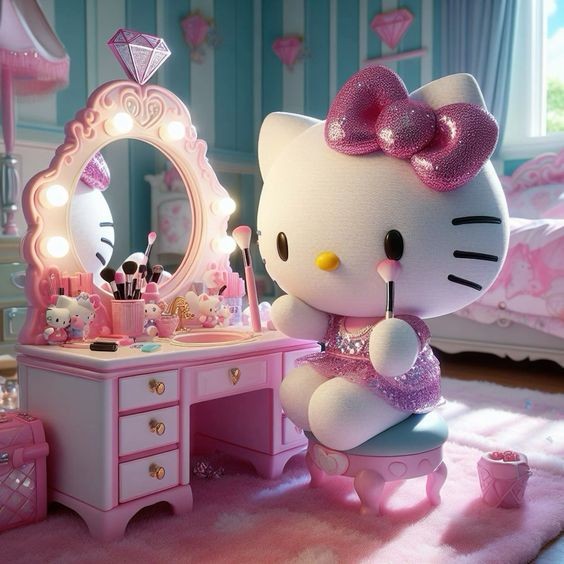The Cultural Phenomenon of Hello Kitty: An In-Depth Exploration
Introduction
Hello Kitty, the iconic character created by Sanrio, is more than just a charming design; she is a global phenomenon. Since her debut in 1974, Hello Kitty has transcended cultural and generational boundaries, becoming a symbol of cuteness and a key player in the world of licensing and merchandising. This article delves into the origins, evolution, cultural impact, and ongoing relevance of Hello Kitty.
Origins and Creation
Hello Kitty, originally known as "Kitty White," was created by Yuko Shimizu, a Japanese designer working for Sanrio, a company specializing in creating cute characters and novelty items. The character first appeared on a vinyl coin purse, which was released in Japan on November 1, 1974. The character’s design features a white cat with a red bow and no mouth, a feature that has been both distinctive and pivotal to her identity.
Sanrio's decision to give Hello Kitty a simple, mouthless face was intended to make her more relatable and emotionally resonant. The idea was that without a mouth, Hello Kitty could convey a wide range of emotions and expressions, allowing her to be a more universal symbol of joy and comfort.
Evolution and Expansion
The 1980s marked a significant turning point for Hello Kitty as she began to gain international fame. The character's simple yet endearing design, combined with Sanrio’s strategic marketing, helped Hello Kitty expand beyond Japan. By the late 1980s, Hello Kitty had become a global brand, appearing on various products including stationery, toys, and apparel.
Hello Kitty's brand expansion was not limited to merchandise. The character became central to a broad range of media including television shows, books, and even video games. Sanrio also created a fictional world for Hello Kitty, complete with a family, friends, and a detailed backstory, further enriching the character’s appeal.
Cultural Impact
Hello Kitty’s impact on popular culture is profound and multifaceted. She represents a significant moment in the globalization of Japanese pop culture, serving as a bridge between Eastern and Western markets. Her ubiquitous presence in various forms of media and consumer products highlights her role as a cultural ambassador.
One of the most interesting aspects of Hello Kitty's cultural impact is her ability to transcend age demographics. While originally designed for children, Hello Kitty has also captured the hearts of adults. Her design has been embraced by a wide range of age groups, reflecting a broader trend in which nostalgia and the appeal of cuteness can resonate across different life stages.
Hello Kitty’s influence extends to fashion, with high-profile collaborations with designers and brands such as Marc Jacobs, Sephora, and even luxury fashion houses like Prada. These collaborations have helped cement Hello Kitty’s status as a fashionable icon, contributing to her enduring popularity in the fashion world.
The Economics of Hello Kitty
Hello Kitty has become a lucrative brand for Sanrio, with a merchandising empire that spans numerous categories. The character’s presence on a wide array of products—ranging from kitchenware to electronics—demonstrates the effectiveness of Sanrio’s licensing strategy. The brand’s ability to adapt and diversify its product offerings has been key to maintaining Hello Kitty’s relevance and appeal.
The economics of Hello Kitty also involve a robust global licensing network. Sanrio has expertly managed partnerships and collaborations to keep the character fresh and engaging. This strategic approach has allowed Hello Kitty to penetrate various markets and maintain a strong brand presence.
Criticisms and Challenges
Despite her widespread success, Hello Kitty has faced some criticisms and challenges. Some critics argue that the character's commercialization has led to an overexposure, potentially diluting her original charm. Additionally, the character’s simplistic design has sometimes been viewed as a symbol of consumerism and superficiality.
Sanrio has also had to navigate cultural sensitivities in its global expansion. Different markets have varying tastes and preferences, which means that Hello Kitty’s branding and product lines often need to be tailored to suit local cultures and values.
Legacy and Future
The legacy of Hello Kitty is one of enduring appeal and cultural significance. As a symbol of cuteness and positivity, Hello Kitty continues to resonate with fans around the world. Her ability to adapt and evolve has ensured that she remains relevant in a rapidly changing cultural landscape.
Looking to the future, Hello Kitty’s brand is likely to continue evolving. Sanrio's efforts to innovate and diversify, including exploring new media formats and interactive experiences, suggest that Hello Kitty will remain a key player in popular culture. The character’s adaptability and enduring charm are likely to sustain her appeal for years to come.
Conclusion
Hello Kitty is more than just a cartoon cat; she is a cultural icon who has made a significant impact on global pop culture. From her modest beginnings as a vinyl coin purse to her status as a global brand, Hello Kitty's journey reflects broader trends in commercialization, fashion, and media. Her ability to resonate with audiences of all ages and cultures underscores her unique place in the cultural zeitgeist. As Hello Kitty continues to evolve, her legacy as a symbol of joy and cuteness remains a testament to the power of effective branding and universal appeal.






